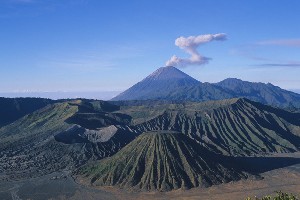
Post-caldera vents of Tengger Caldera - Batok in center, Bromo to its left. Semeru smoking in background (2004)
Strombolian activity in Bromo Crater, 2011
 |
|
|
Post-caldera vents of Tengger Caldera - Batok in center, Bromo to its left. Semeru smoking in background (2004) |
Strombolian activity in Bromo Crater, 2011 |
|
Bromo erupting in 2011 |
Bromo erupting in 2011 |
Bromo erupting in 2011 - Batok cone to right |
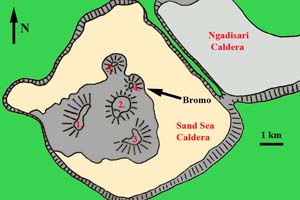 |
1. Segarawedi Kidul (2661m)2. Segarawedi Lor (I and II) (2650m)3. Mount Kursi (2581m)4. Mount Bromo (2392m)5. Mount Batok (2470m) |
|
Fig.1 Sketch Map of Tengger (Sand Sea) Caldera |
|
Bromo crater during pause in activity |
Walking along east rim of Segarawedi Lor, approaching Bromo |
Vent during pause in activity |
|
Strombolian eruptions of Bromo at night |
|
Strombolian eruptions of Bromo at night |
|
Degassing |
Ash eruption |
Ash eruption |
|
Minor emission of gas with traces of ash |
Ash eruption |
Weak strombolian activity accompanied by strong degassing |
|
View to rim from east flank |
Large lava bomb on flank |
|
Trails on flank mark path of bombs |
Trail left by bomb in barren landscape |
Small bomb at end of trail |
|
Forest on flank killed by heavy ashfall |
|
Large bush completely smothered by ash |
Ash on flank |
Extensive ash deposits, Batok in background |
|
Building buried by ash at base of Batok |
Moisture condensing in cloud above crater |
View from Batok with dead vegetation in foreground |
|
View from Batok with dead vegetation in foreground |
Minor ash eruption |
|
Pura Luhur Poten temple in foreground with erupting Bromo behind |
Pura Luhur Poten temple |
|
Pura Luhur Poten temple with ash cloud passing overhead |
Pura Luhur Poten temple viewed from trail up Batok |
|
Footprint in fresh ash |
Fern coated in ash |
Plant buried in ash |
|
Dead forest on east flank of Bromo |
Plant smothered by ash |
Locals clear trees broken by ash from road into caldera |
|
Agricultural land smothered in ash, 10km SSE of Bromo |
Trees snapped by weight of ash in caldera |
Crops bent and broken by ash fall |
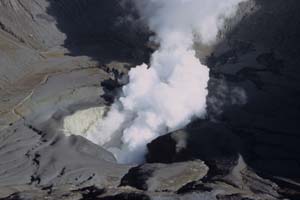 |
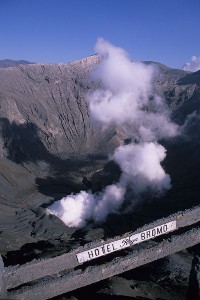 |
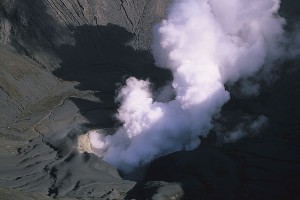 |
|
View into Bromo Crater, July 2004 |
View into Bromo Crater, July 2004 |
View into Bromo Crater, July 2004 |
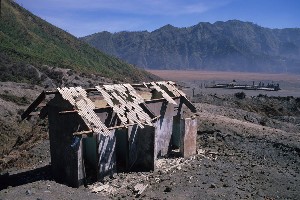 |
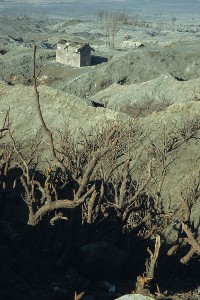 |
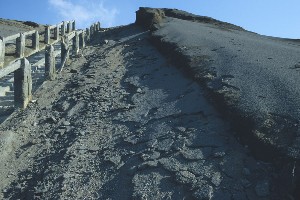 |
|
Building on Flank of Bromo with Roof Destroyed by 2004 Eruption |
Vegetation Damaged by Impact of Bombs from 2004 Eruption |
Fresh Lapilli from 2004 Eruption by Staircase |
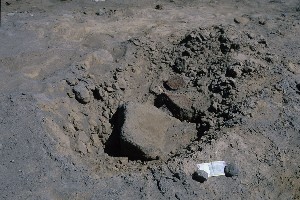 |
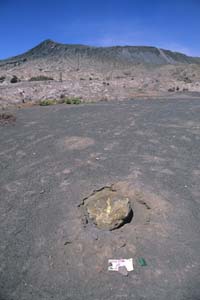 |
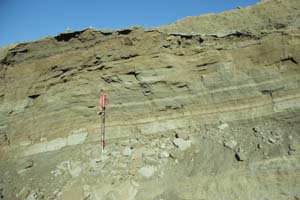 |
|
Volcanic Bomb from 2004 Eruption (Banknote for Scale) |
Volcanic Bomb from 2004 Eruption |
Ash Deposits on Flank of Bromo |
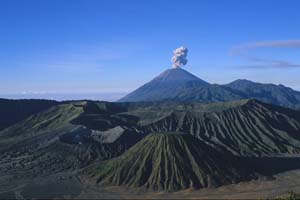 |
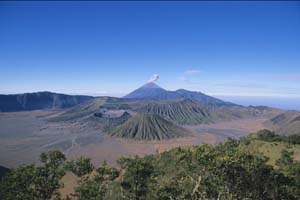 |
|
Morning View from Mt. Penanjakan Viewpoint |
Expansive Morning View from Mt. Penanjakan Viewpoint |
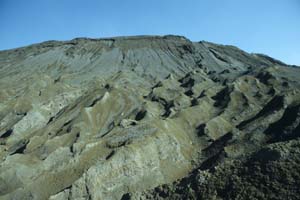 |
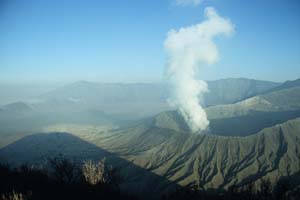 |
|
Erosion Valleys on N Flank of Bromo |
Evening View of Bromo from Batok |
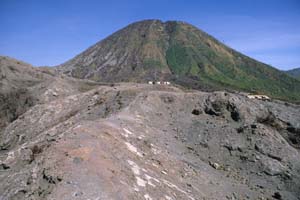 |
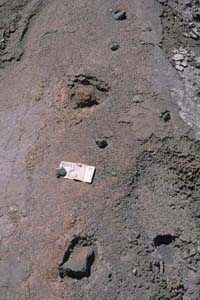 |
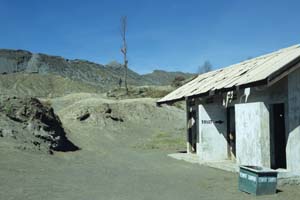 |
|
View from Bromo Flank to Batok |
Multiple Small Impact Craters from 2004 Eruption (Located in Foreground of Picture to Left) |
View from Base of Caldera to Bromo. Note Impact Damage to Roof of Toilet |
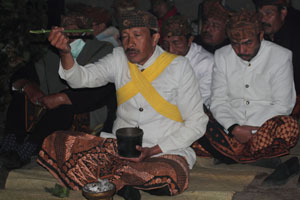 |
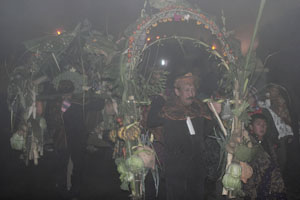 |
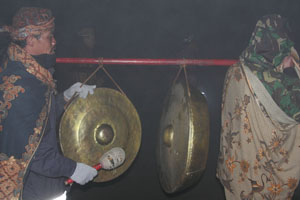 |
|
Priests performing ceremony before procession |
Procession through dense fog on caldera floor |
Musicians accompanying procession |
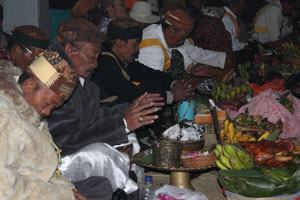 |
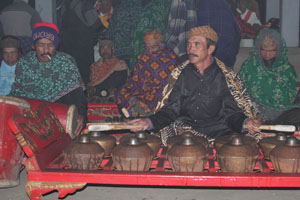 |
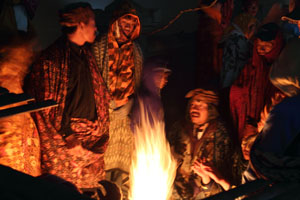 |
|
Priests meditating in Pura Luhur Poten temple |
Musical accompaniment of ceremony |
Pilgrims keep warm by fire in temple compound |
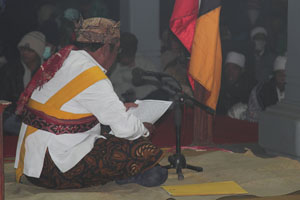 |
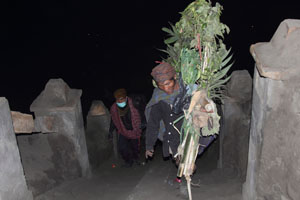 |
|
Priest holding speech in Pura Luhur Poten temple |
Sacrificial “wreath” being carried up stairs to Bromo crater |
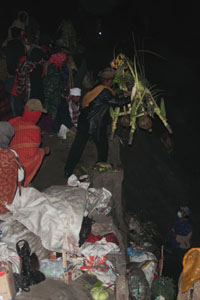 |
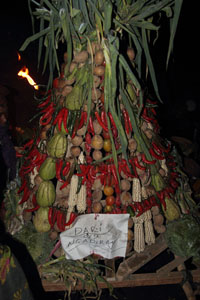 |
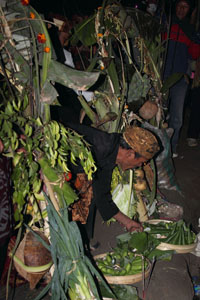 |
|
Sacrificial “wreath” being thrown into Bromo crater |
Bundle of agricultural produce for throwing into crater |
Priest with sacrificial “wreaths” on crater rim |
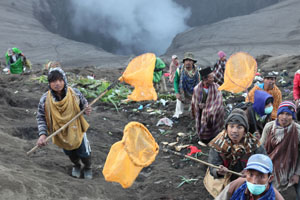 |
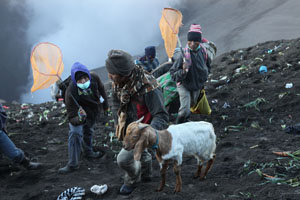 |
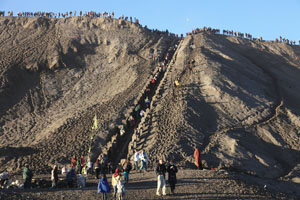 |
|
Waiting to catch sacrificial goods in crater |
Sacrificial goat being retrieved from crater |
Pilgrims and onlookers ascending stairs to crater rim |
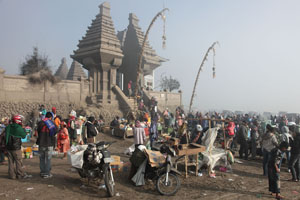 |
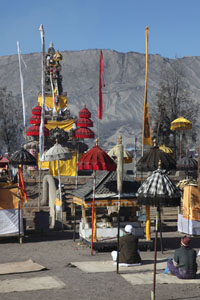 |
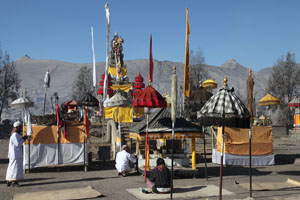 |
|
Pura Luhur Poten temple |
Pura Luhur Poten temple with Bromo Volcano behind |
Pura Luhur Poten temple with Bromo Volcano behind |